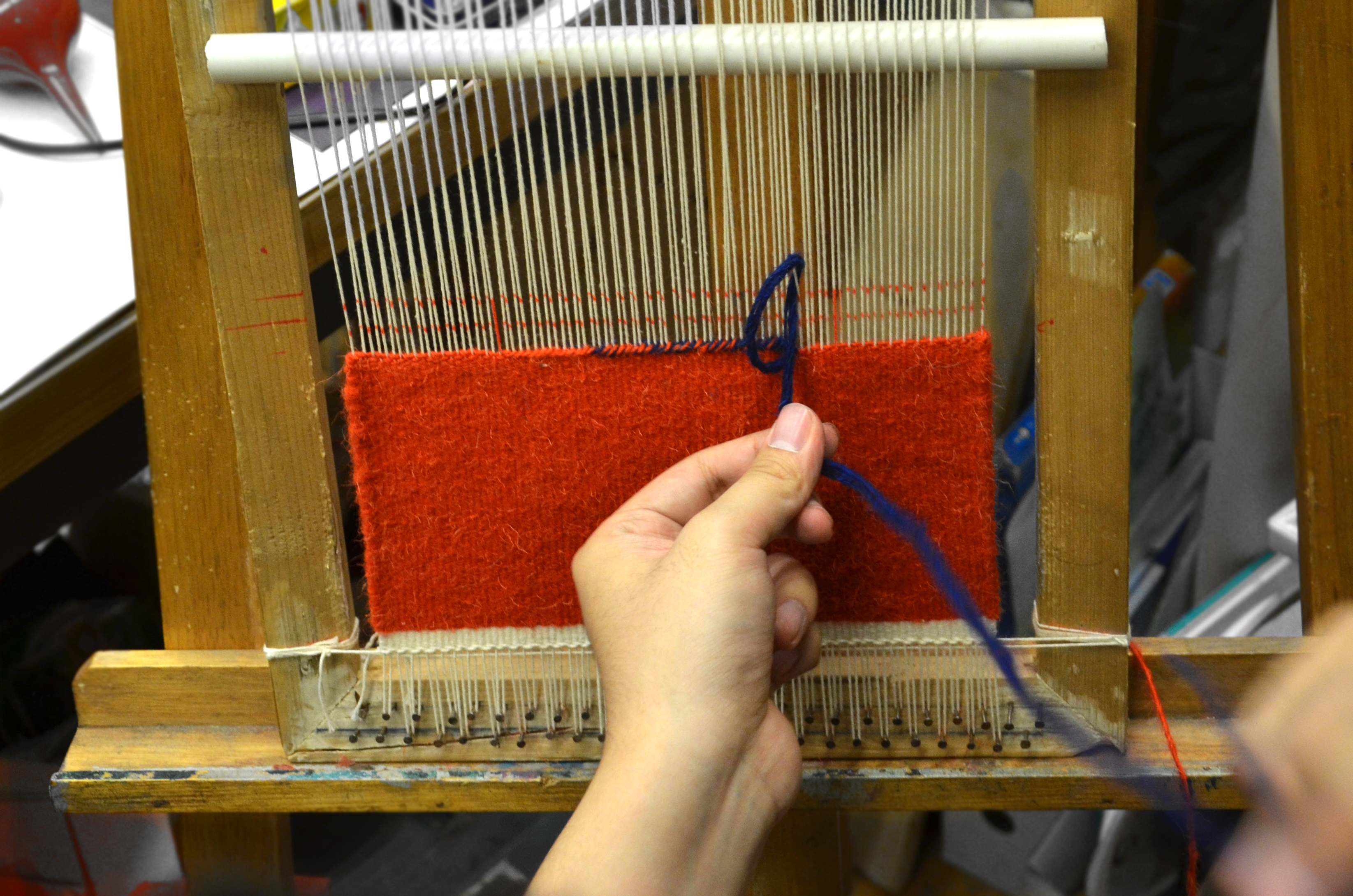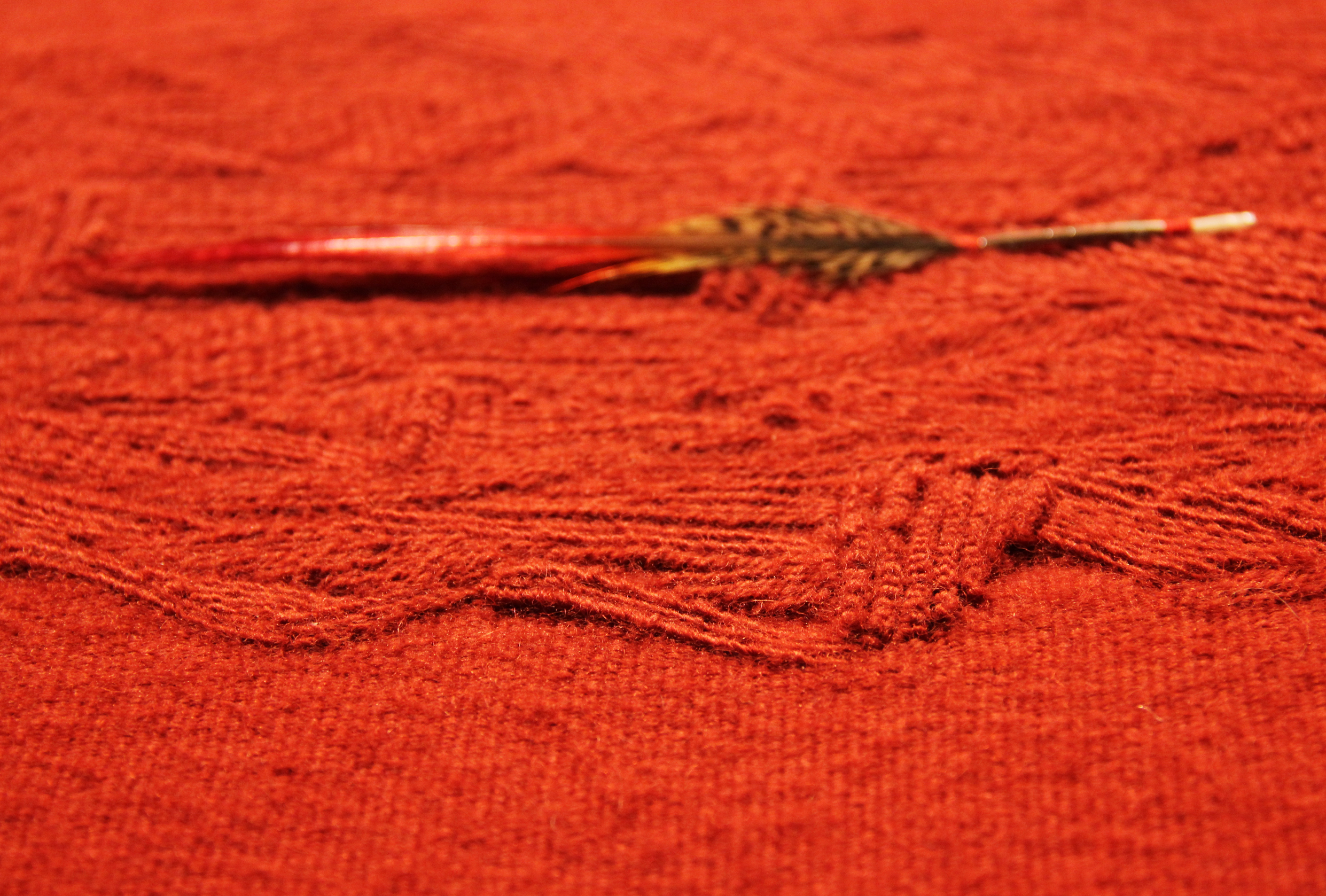致彼埃 · 蒙德里安 To Piet Mondrian
学士学位毕业设计/B.F.A. Thesis戈贝兰壁毯;羊毛、棉、羽毛;45 x 45 cm/Gobelin tapestry; wool, cotton, feather; 18 x 18 inch
2014年春,中国北京/Spring 2014, Beijing, China
我把我的本科毕业设计当做是一次很好的尝试自主探究项目的机会。我想要向我最喜欢的艺术家之一彼埃 · 蒙德里安致敬,正因为他给了我灵感让我探索几何与极简主义。因此,我做了大量调研与试验来探究他在平面构成与色彩搭配上的 “秘密公式” 并将探究结果应用于我的设计上。
在这个项目中,在工艺层面上,有别于传统壁毯,我将 “羽毛” 这种当代艺术媒材引入到了传统的戈贝兰壁毯工艺中来探索编织工艺的潜力、可塑性和延展度。同时,我还发明了我自己的创新编织技法 “高级渐变苏玛克”。它可以实现在颜色与尺寸上的渐变效果。
I consider my B.F.A. Thesis as a great opportunity to start a conceptual self-generated project. I want to show my dedication and salutation to one of my favorite artists—Piet Mondrian, who inspires me to experiment geometry and minimalism. Therefore, I did lots of research and experimentation to figure out the “secret formula” of his composition and color scheming and transfer them into my design.
In this project, on the craft level, unlike traditional tapestry, I introduce contemporary material “feather” into the traditional Gobelin tapestry to explore the potential, plasticity, and extensity of weaving techniques. Meanwhile, I also develop my own creative contemporary weaving technique—“Advanced Gradient Soumak”—which is able to accomplish gradient effects in both color and size.
本科生毕业展览/B.F.A. Show
2014年06月05日至15日/June 5th–15th, 2014
清华大学美术学院B区展厅/Academy of Arts & Design, Tsinghua University

草图/Sketchboard



材料与技法探索/Material & Techinique Exploration
我很容易被各种不同材料吸引,并且我会去触摸它们、感受它们并去尝试理解它们。我探索了羊毛的可塑性和更多新技术的可能性。经过试验后,我发明了 “优化苏玛克” 技法。它是基于由于肌理过于粗糙而被抛弃的原始苏玛克技法的再创造。但 “优化苏玛克” 可以实现更纤巧且精致的颜色和尺寸的渐变。
羽毛也是一种很好的材料。它拥有美轮美奂的光泽和形态。我发现了一种方法可以将羽毛坚实地固定在壁毯上以实现它们之间的对比与和谐。
I am always obsessed with various materials and I would love to touch them, feel them, and comprehend them. I explored the plasticity of wool and more possibilities of new techniques. After experimentations, I innovated the “Refined Soumak,” which is based on original Soumak that was abandoned because of its rough texture. However, “Refined Soumak” offers a more sensitive and delicate gradient on both colors and sizes.
Feather is also a great material. It has breathtakingly gorgeous gloss and form. I figured out a way to fix it onto the tapestry to spectate the comparison and chemistry.





羽毛材料再造/Feather Manipulation
 01. 将苯板藏于毯背;用密度板加固;用订书针使位置固定。
01. 将苯板藏于毯背;用密度板加固;用订书针使位置固定。02. 将羽茎根部剪掉;把五根捆成一捆,这样可以使羽茎更坚硬且利于穿刺。
03. 将定位草图致于毯面;用珠穿孔定位,将草图、壁毯和苯板一同刺穿。
04. 将珠针移除;用锥子将穿孔扩大;在捆好的羽茎尾端上胶并置于定位中。
05. 测试牢固度;然后用密度板做模拟画框;用黑色丙烯颜料上色。
06. 将完成的壁毯测试样品置入画框;用双面胶固定;用笔刷将羽毛调整到理想的状态。
01. Hide polystyrene board behind the tapestry; Reinforce it by medium density fiberboard; Use staples for immobilizing.
02. Cut off the tails of feather; Bundle five pieces of them together as a wisp, which hardens the quills and makes wedging efficiently.
03. Place locating points sketch on the tapestry; Penetrating each hole on the sketch, tapestry, and polystyrene board together with pins.
04. Pull out the pins; Enlarging the holes using an awl; Glue the tails of the wisps and put them into the holes.
05. Test the outcome; Make a simulated frame by polystyrene board; Paint by black acrylic.
06. Place finished tapestry in the frame; Tape it down with double sided tape; Use a brush to adjust it to ideal shapes and forms.
细节/Details





Special Thanks to
洪 兴宇/Xingyu Hong
林 乐成/Lecheng Lin
周 倩楠/Qiannan Zhou
林 乐成/Lecheng Lin
周 倩楠/Qiannan Zhou
#自主探究项目/self-generated project
#当代技艺/contemporary technique
#创意编织工艺/creative weaving
#壁毯/tapestry
#几何构成/geometric composition
#极简主义/minimalism